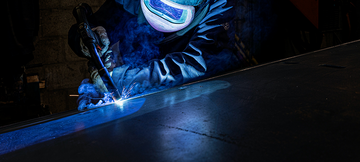
Make no mistake, welders know their profession is dangerous. The complexity of the work doesn’t help matters, nor the tight productivity schedules or the potentially hazardous environments the work is carried out in. Then there’s the high-amperage power source and a panel full of equipment settings to master, too.
There are sparks flying, molten metal flowing within arm’s reach, eye-damaging quantities of ultraviolet light thrown out by the arc, and all kinds of toxic fumes swirling around the weld area, yet this challenging occupation must be mastered. Complex or not, safety-challenged or not, the work has to be done and done right. Just to reiterate, welders know their occupation is dangerous and tough to master, so they make a point of exercising common sense. Even so, common sense is no substitute for proper training.
With these thoughts in mind, welding machine operators need proper training if they’re to apply first-class welds safely and accurately. Technique is taught to prospective welders so that each and every job they undertake satisfies the rigorous demands of an established set of quality control standards. It’s the same with equipment training, the ins-and-outs of gear usage must be intimately known, all the better to ensure a safe and properly applied weld. Talking of safety, that’s the most important of this group of welding machine operator training dictates. All work must be done in a professional manner, but it must also be managed in a way that’s safe for the welder, too.
Properly Trained for a Safety-First Welding Career
Add the potential for serious electrical shocks to the list. In generating an arc that’s capable of turning hardened metals into a molten puddle, high voltages are required. If a welder, someone who’s focused solely on doing the job at hand, touches a workpiece and forms a bridge between the “hot” work lead and ground, then a circuit is established. The hazardous voltage flows through a human body instead of the weld site. A harmful electric shock, a possibly fatal one, takes place. Training is essential as a means of managing such high voltages. That knowledge also educates the welder on other site dangers, including toxic fumes, eye protection, and skin harm. We are, after all, essentially fragile creatures. Imagine the harm a super-heated weld pool could do to unprotected skin.
And that’s the key, the absolutely must-have presence of protective gear. With training, welders know they have to wear eye and skin protection. That means getting into the habit of using welding helmets and eye protecting visors. It means wearing heat-resistant gloves, items that’ll prevent sparks and splatter from reaching a welder’s flesh. Even a good pair of work overalls is advised in a training program, for welding machine operators don’t settle for a single layer of protection when two or three are available. Again, with training, welders know that they need to be dressed for their occupation before they ever get near a new job.
The Importance of Technique and Equipment Education
Not just anyone can pick up an arc welding rod. Exhaustive instruction and practice creates quality welding professionals. To this end, trade tests and merit-based certifications are used to determine skill levels and equipment familiarity. These certifications attest to a worker’s ability to comply with certain welding codes and performance standards. Back at the training program, codes taken from the ASME (American Society of Mechanical Engineers) and AWS (American Welding Society) are applied in the United States. Other nations will, of course, use their own versions of these standards and regulations. They act as a training framework, as a system of guiding rules for each and every welder who undertakes a certification scheme. Course curriculums focus on technique, on welding positions, including basic horizontal welding methods, and on the different types of joints available.
And that brings us neatly to the complexity inherent in this work. Positions are one issue. As skills are gained, welders are asked to apply joints in ever more challenging settings. One welder might awkwardly apply a bead overhead. He needs to master this awkward position, and this is done through more training. Structural work at a 90-degree angle adds another layer of complexity, as does a second tough to weld angle that’s being managed on a large-bore pipe. The material being welded and the filler used, the welding machine utilized, the consumables fitted, the shielding gas ratio established, even the penetration characteristics of the weld pool as it’s manipulated, all of these work factors must be managed. And, as already illustrated throughout this post, that can only be assured by gaining the correct certification, which can only happen through training.
One final thing. Welding education doesn’t follow a fixed learning curve. There’s always more to learn, so the training a welder will encounter is going to be on-going. A new position will need to be certified if the operator starts a new job. Perhaps he’ll be working on pipes or structurally important workpieces. A vertically moving bead needs to be mastered, so it’s back to the class to learn all there is to know about this method.
New equipment types are added to the arc welding repository, with new setup routines and troubleshooting guides changing the workflow ever so slightly. Again, more training is required if a quality-assured weld is to be guaranteed. Productivity is kept satisfactorily high and the operator safely goes about his business, all thanks to the newly gained education. To be sure, safety always comes first, but technique and equipment mastery are close behind. Without that training, productivity would slow, welding inspectors would question the quality of a weld, and there would be no confidence in the arc welding equipment being used. That’s not an acceptable situation, nor is it acceptable to send in a welder without safety training. Lives are at risk, but that risk factor is minimized when the right protective gear is worn. Properly educated and certified, trained welders are safe welders.
